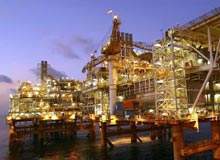
Bayu-Undan, in the Timor Sea, has estimated gas reserves of 3.4 trillion cubic feet. Processing of this natural gas takes place at the Darwin LNG facility, which was commissioned in February 2006 and delivered first cargo of LNG to Tokyo Electric and Tokyo Gas.
The $1.8bn scheme included the construction of an LNG plant at Wickham Point, Darwin Harbour, and a 502km gas pipeline from Bayu-Undan gas reserve to Darwin.
Construction work on the Darwin LNG project began in June 2003 and the plant was operational by February 2006, four months ahead of schedule.
Sponsored by Conoco Phillips (which discovered the Bayu-Undan reserve in 1995), Tokyo Electric and Tokyo Gas, the project strengthens the economy in Australia and Timor Leste (formerly East Timor). Timor Sea Designated Authority approved the project and Bechtel Australia Pty Ltd was responsible for the construction.
BAYU UNDAN FIELD
The Bayu-Undan Field is located in the Timor Sea, approximately 500km north of Darwin and 250km south of Timor Leste. The offshore facility connected to the field currently produces over 110,000 barrels of liquid condensate a day and also relays gas via the pipeline to the Darwin LNG plant, where it is then converted into liquefied gas for export (22 million cubic metres a day).
Reserves in the field are estimated at 96 billion cubic metres of gas and 64 million cubic metres of condensate (400 million barrels). Companies with interests in Bayu-Undan include ConocoPhillips, the operator (56.72%); ENI (12.04%); Santos Group (10.64%); INPEX (10.52%) and Tokyo Electric Power Company (TEPCO), Incorporated / Tokyo Gas Co, Ltd (10.08%).
DARWIN LNG PROJECT SPECIFICATIONS
The Darwin LNG project was built in two phases: a 502km, 26in-diameter subsea pipeline and a 3.24mtpa-capacity LNG plant. The LNG plant features:
- A 92m-diameter, 47m-high LNG storage tank to hold up to 188,000m³ of gas
- LNG process area – for treating and liquefying raw gas
- Marine jetty for delivering liquefied gas to cargo ships for transportation
The project site clearance and works on LNG train, storage and loading facilities was executed in accordance to an Operations Phase Environmental Management Programme (OEMP).
LNG PLANT – PROCESSING NATURAL GAS
The LNG plant processes the natural gas and cools and compresses it for storage in an LNG tank prior to export. The plant infrastructure includes a smaller single LNG processing train with a normal capacity of 3.24mtpa. An inlet metering station to meter the incoming gas stream for domestic natural gas sales was also set up.
Philips optimised cascade LNG process liquefaction technology is used in the project. This technology was also used in the Conoco Phillips Kenai LNG plant in Alaska for the first time and in the Atlantic LNG facility in Trinidad. The LNG plant uses low-emission, aero-derivative-designed high-efficient gas turbines for refrigerant drivers.
PIPELINE CONSTRUCTION
An access road to the project site was constructed by the government for the transportation of construction equipment, materials and personnel. A pipeline for transporting potable water to the site was also constructed prior to work starting on the plant. This pipeline is also linked to the Northern Territory Power and Water Authority (PAWA) supply system.
Construction work also included LNG tanks, LNG train, utilities, storage and loading systems. In addition a jetty on the west side of Wickham Point and a dock on northeast were constructed.
MATERIALS
The total project involved 700,000m³ of earth works, 55,000m³ of concrete, 4,500t of structural steel, 85km of piping, 650km of wire and cable and a 1.5km-long jetty.
A plate for 26in-diameter pipeline was manufactured in Japan and the 292,000t of pipe was transported to Kuantan in Malaysia, where external concrete and anti-corrosion coating and internal coating was applied to the pipes.
BENEFITS
The project enables Australia and Timor Leste to commercialise the hydrocarbon resources within the Joint Petroleum Development Area (JPDA). The treaty between Australia and Timor Leste will benefit the region as the Darwin LNG project will result in new employment opportunities and demand for local goods and services. The treaty also allows them to share the gas production, taxes and export earnings.
In addition an agreement has been reached over the adjacent Sunrise Field and the gas from here may well be processed at Darwin as well. This would require construction of an additional 250km pipeline to tie-back into the system.
KEY PLAYERS
ConocoPhillips sponsored the project and the $1bn LNG plant construction contract was awarded to Bechtel Australia. Subcontracts worth $230m involving different works were awarded to Thiess, Sunbild (temporary warehouse), ATCO (temporary offices), Fleetwood (camp construction), Thiess (marine), Particks (customs brokerage), Wagners (batch plants) and Panalpina (freight forwarding).
Another major contract worth $400m for the construction of the 500km pipeline was awarded to Multiplex / Saipem. Other contracts worth AU$220m for chemical cleaning, fire proofing, asphalt paving, permanent buildings, non-destructive testing, heavy lifting transport and cryogenic insulation were awarded to various other smaller contractors.



